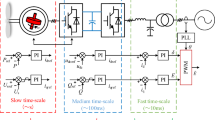Abstract
In order to study the phenomenon of sub-synchronous oscillation (SS0) in thermal power plants considering different topologies, based on the IEEE first standard model, this paper uses the PSCAD simulation platform to build models of different topological structures of thermal power plants. The complex torque coefficient (CTC) analysis method is used to obtain the electrical damping (De) in each topology. The analysis shows that the topology will affect the sub-synchronous oscillation, if the system topology is more complex, the system’s ability to withstand the sub-synchronous oscillation will be stronger, and it is verified by time-domain simulation..
Access this chapter
Tax calculation will be finalised at checkout
Purchases are for personal use only
Similar content being viewed by others
References
Cheng, S., Cao, Y., Jiang, Q.: Theory and method of subsynchronous oscillation in power system. Beijing Science Press, vol. 68, pp. 84–90 (2008)
Livermore, L., Ugalde-Loo, C.E., Mu, Q., et al.: Damping of subsynchronous resonance using a voltage source converter-based high-voltage direct-current link in a series-compensated great Britain transmission network. IET Gener. Transm. Distrib. 8(3), 542–551 (2014)
Wang, K., Xu, Z., Du, N., et al.: Subsynchronous resonance by thyristor controlled series compensation. High Volt. Eng. 42(1), 321–329 (2016)
Xu, Y.: Research on damping control of subsynchronous oscillation in HVDC transmission based on observability and controllability. Power Syst. Prot. Control 41(9), 21–26 (2013)
Li, G., Zhang, S., Zhang, Z.: Analysis of the possibility of subsynchronous resonance under the high series compensation level of the 330 Kv main network in Northwest China by frequency scanning method. Proc. CSEE 12(1), 58–61 (1992)
Wang, Z., Wang, L., Xie, X., et al.: A method integrating frequency scanning and complex torque coefficient to quantitatively evaluate subsynchronous resonance risk. Power Syst. Technol. 35(7), 101–105 (2011)
Yang, X.: Study on network topology analysis and operation modes combination in power system, vol. 27. Huazhong University of Science and Technology, Wuhan (2007)
Li, H., Chen, Y., Zhao, B., et al.: Analysis and control strategies for depressing system sub-synchronous oscillation of DFIG-based wind farms. Proc. CSEE 35(7), 1613–1620 (2015)
Wang, J., Guo, C., Guo, X., et al.: Realization of PSCAD/EMTDC based complex torque coeffient approach. East China Electr. Power 38(12), 1854–1857 (2010)
Huang, L., Li, J., Liu, X., et al.: Realization of complex torque coefficient method in time domain based on PSCAD/EMTDC and research on the influence on electrical damping. Sensor World 24(2), 13–18 (2018)
Acknowledgment
This work was supported by the National Science Foundation of China under Grant (51677057), Local University Support plan for R & D, Cultivation and Transformation of Scientific and Technological Achievements by Heilongjiang Educational Commission (TSTAU-R2018005) and Key Laboratory of Modern Power System Simulation and Control & Renewable Energy Technology, Ministry of Education (MPSS2019-05)
Author information
Authors and Affiliations
Corresponding author
Editor information
Editors and Affiliations
Rights and permissions
Copyright information
© 2020 ICST Institute for Computer Sciences, Social Informatics and Telecommunications Engineering
About this paper
Cite this paper
Cui, H., Su, X., Pei, Y., Zhao, S. (2020). Research on SSO Influence with Consideration of Topology Structure Based on CTC Analysis Method. In: Jiang, X., Li, P. (eds) Green Energy and Networking. GreeNets 2020. Lecture Notes of the Institute for Computer Sciences, Social Informatics and Telecommunications Engineering, vol 333. Springer, Cham. https://doi.org/10.1007/978-3-030-62483-5_2
Download citation
DOI: https://doi.org/10.1007/978-3-030-62483-5_2
Published:
Publisher Name: Springer, Cham
Print ISBN: 978-3-030-62482-8
Online ISBN: 978-3-030-62483-5
eBook Packages: Computer ScienceComputer Science (R0)




